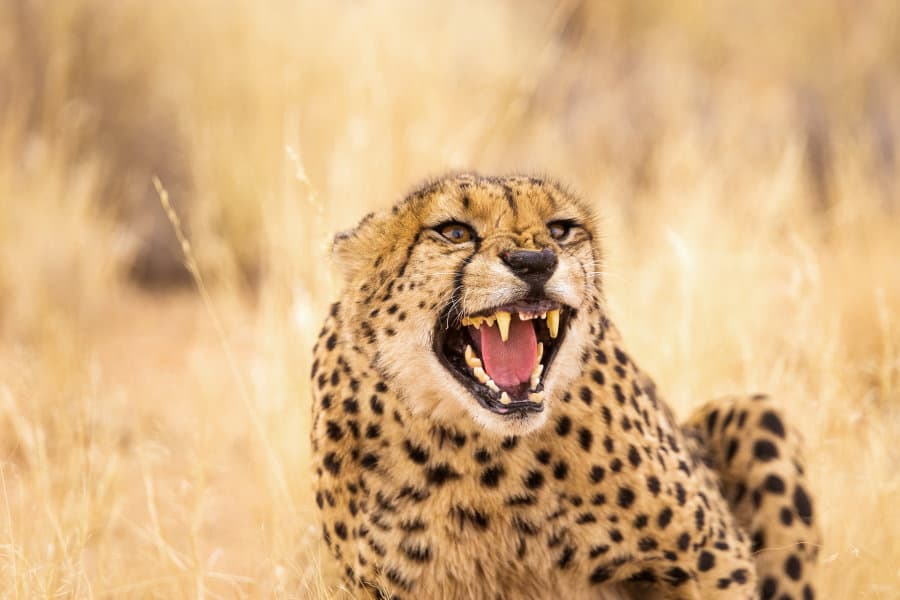If you’re a lover of Africa, there’s no question about knowing the sounds of the wild. The distance roar and grumble of a lion are an iconic part of Africa. When it comes to the elephant, the rumbling and trumpeting are just as memorable.
The cheetah, on the other hand, stands out for different reasons. Its agile speed and spotted coat deem them an animal that’s recognized in all parts of the world. The one thing we don’t know so much about, however, are cheetah noises.
With an estimated running speed of 80-120 kph, do these nimble creatures need a voice box that powers their surroundings? Is a soft meow all these cats need to show their affection to one another? Or is a strong growl their sound of choice?
Let’s take a look at the sounds made by a cheetah.
A Cheetah Roaring: Will You Ever Hear It?
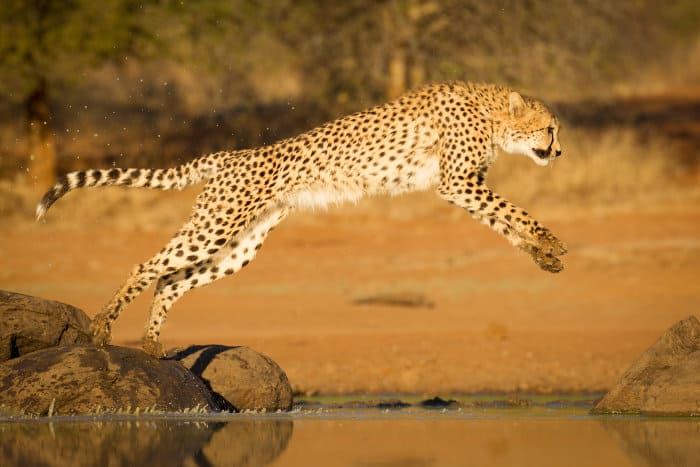
The name ‘cheetah’ comes from the Sanskrit word ‘chitraka’, meaning the spotted one. These pretty cats have magnificent patterning and incredible speed, it would seem to be unfair to gift them with a powerful roar as well.
So the roar is one thing that the cheetahs miss out on.
Why can’t cheetahs roar?
Have you ever wondered why cats, who are part of the same family, might not always share the same traits?
Take roaring and purring for example.
Smaller cats, who love to purr, will never grow up and learn to roar. While a lion can never show their contentment with a gentle purr.
The cat family, Felidae, forms two subfamilies; Pantherinae, and Felinae. Those who can roar fit into the Pantherinae subfamily, while cats who can purr are part of Felinae.
In fact, there are only four big cat species that fall into the Pantherinae subfamily, jaguars, leopards, tigers, and lions.
The sound production all comes down to a tiny little bone situated near the larynx, the epihyal bone. This tiny bone allows cats, including the cheetah, to purr.
Big cats lack this bone, and instead, replace it with ligaments. These ligaments are so powerful that when stretched, they can produce loud roars that travel a couple of kilometers.
That little bone is also the reason why you will never hear a cheetah roar.
Cheetah Noises You Can Expect to Hear in the Wild
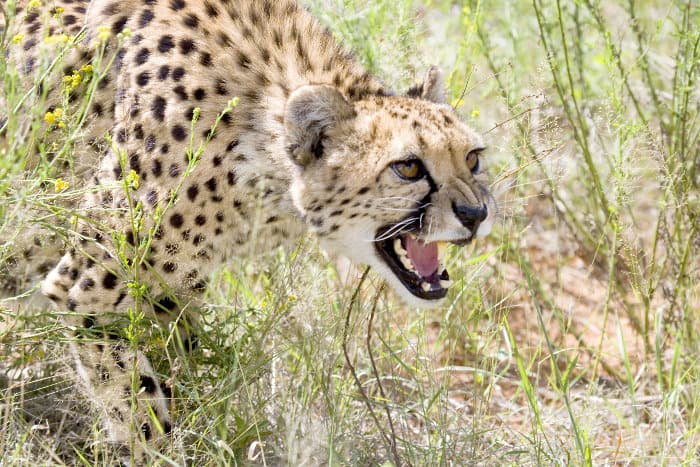
The roar isn’t the only useful sound out in the wild. Cheetahs produce a variety of different sounds to communicate with each other and to warn humans and other animals of their presence.
And when you compare them to other cats in their family, cheetahs are the most vocal.
Cheetah chirping
A chirp is similar to a bird’s chirp, it may even be mistaken for one. It’s usually produced between a mother and her cubs, as it is a useful sound for locating one another.
Stuttering: mating sounds
Researchers have learned that during the mating season, male cheetahs make a unique stuttering sound. Almost like a stuttered bark. The sound resembles a combination between a purr and a rumbling stomach.
What sound do cheetahs make when threatened?
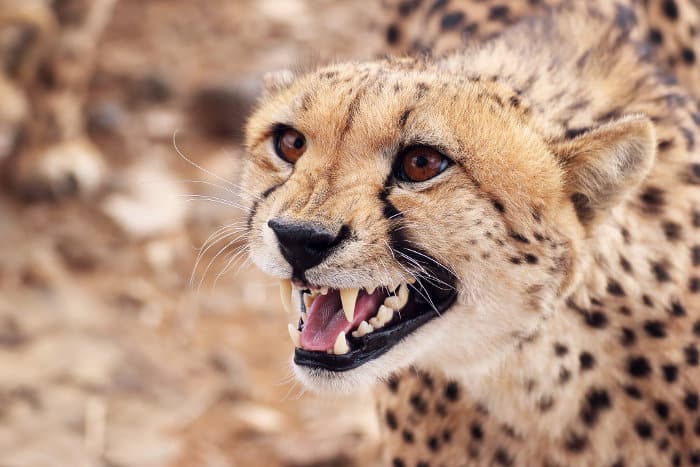
You’ll automatically know when a cheetah feels like they are being threatened. As soon as they feel threatened, they’ll begin to slowly crouch and start moaning. This is then followed by hissing.
Cheetah growl
If the threat still remains, the cheetah will start growling and showing off their canines. If you’ve ever seen a domestic cat getting angry, you’ll know that one of their main defense tactics is spitting. The cheetah will spit just like them.
Cheetahs can also release an explosive yelp which is able to travel as far as 2 km. It is a lot more powerful than a warning growl.
Cheetahs meowing
Just like sharing the same purring trait, the cheetahs meows are also just as cute as a kitty. They may look imposing, with their exceptional hunting skills making them a fierce predator. However, their bark is definitely not as big as their bite.
Cheetahs produce a meow that is almost identical to our friendlier felines. This all relates back to their voice box. Because cheetahs have the same voice box as domestic cats, they’re free to meow as much as they please.
How do they mark their territory if they don’t roar?

The lion’s roar travels as far as 5 km. This lets other lions know whose territory is whose. So if a lion guards their territory with a roar, what does the cheetah do?
While the cheetah also marks its territory with urine, they aren’t as dominant over territory as many of the other big cats. Therefore, they don’t need to warn off other animals, simple markings will suffice.
More Than Just Cheetah Sounds: Other Communication
Unlike lions, cheetahs don’t form large prides.
Rather, they like to surround themselves with close relatives, and it’s not uncommon to see them in groups of four to six cheetahs.
Or they’ll live a solitary life, and only mingle with others when it’s breeding season.
When greeting familiar faces, you’ll notice that they display similar behavior to friendly dog interactions. Cheek rubbing, sniffing, nuzzling, and licking are common displays of affection.
Cheetahs Can’t Roar, Though Their Meow is Even Better
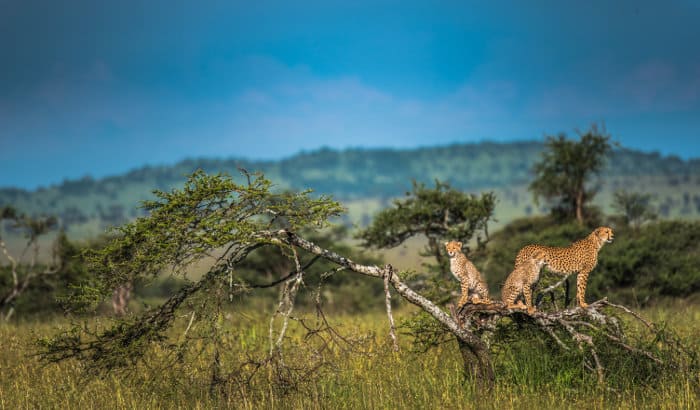
There always seems to be an endless amount we can learn about the animals in Africa. And the cheetah proves it. Who would have thought they’re incapable of a roar? Or that their voice box produces a friendly purr.
These spotted big cats are a vulnerable species. And while there are plenty of chances to see them in captivity, seeing them in the wild is the only way we should be admiring these creatures.
Book yourself a tailor-made safari to hear the fascinating sounds of the cheetah in their natural habitat.
What Sounds Do Other Animals Make?
Well, now you officially know the usual cheetah sound effect. If you’re wondering what other strange noises the animals in Africa make, check out these intriguing animal sounds.
